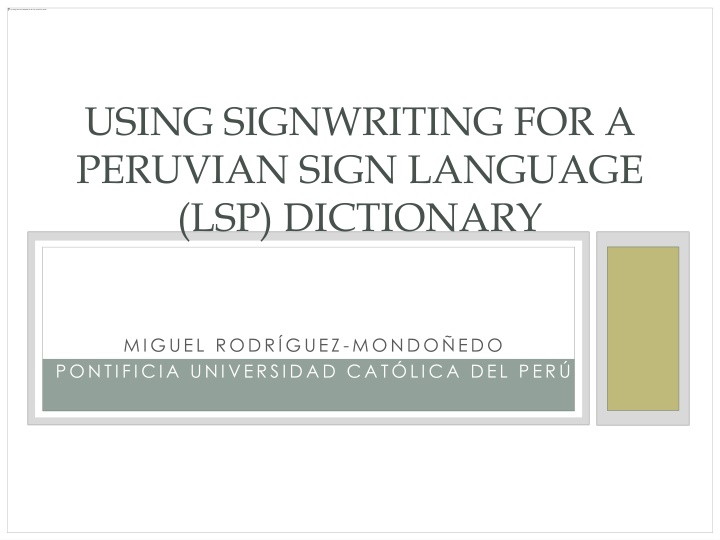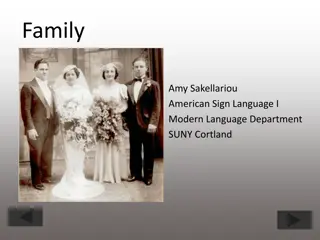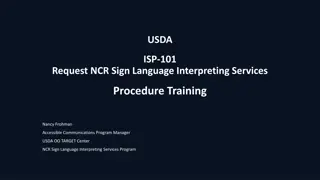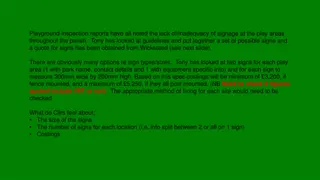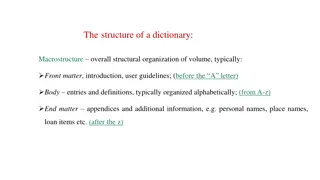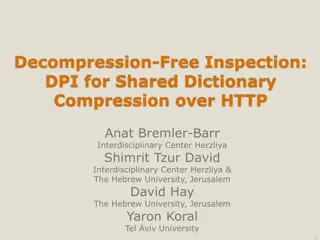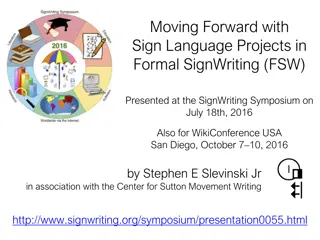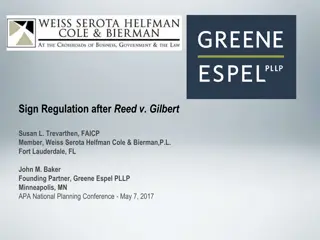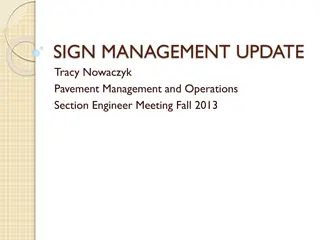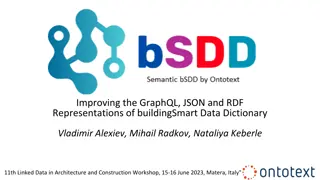Using SignWriting for Peruvian Sign Language Dictionary
In this study, the use of SignWriting to represent lexical entries in a Peruvian Sign Language dictionary is explored. The challenges, antecedents, and overview of the project are discussed, shedding light on the limited information available on Peruvian Sign Language. The research aims to contribute to the understanding and documentation of the language created by the Peruvian Deaf Community.
Download Presentation

Please find below an Image/Link to download the presentation.
The content on the website is provided AS IS for your information and personal use only. It may not be sold, licensed, or shared on other websites without obtaining consent from the author.If you encounter any issues during the download, it is possible that the publisher has removed the file from their server.
You are allowed to download the files provided on this website for personal or commercial use, subject to the condition that they are used lawfully. All files are the property of their respective owners.
The content on the website is provided AS IS for your information and personal use only. It may not be sold, licensed, or shared on other websites without obtaining consent from the author.
E N D
Presentation Transcript
USING SIGNWRITING FOR A PERUVIAN SIGN LANGUAGE (LSP) DICTIONARY MIGUEL RODR GUEZ-MONDO EDO PONTIFICIA UNIVERSIDAD CAT LICA DEL PER
OVERVIEW We will discuss the possibilities of using SignWritting (SW) to represent lexical entries in a Peruvian Sign Language Dictionary (Diccionario Anotado de Lengua de Se as Peruana, DALSP in Spanish). Antecedents: (almost) none Introduction to Peruvian Sign Language Some remarks on Peruvian Deaf Community and their education Properties of DALSP Challenges for SignWritting in DALSP
ANTECEDENTS: (ALMOST) NONE Currently, no published dictionary on Peruvian Sign Language (LSP in Spanish) exists---we are only aware of two lexical repertoires, which basically contain different versions of the same entries: -ASSOLI 2012 (http://www.slideshare.net/assoliperu/documents) -Ministerio de Educaci n 2010 (http://basicaespecial.perueduca.edu.pe/web/libros_digebe/5/files/assets/basic-html/toc.html)
ANTECEDENTS: (ALMOST) NONE In fact, there is almost no research on LSP, and very few systematically gathered data on the language. Almost no known data collected is publically available. For instance researchers from the Summer Institute of Linguistics have a substantial amount of data not intended for publication : http://www.peru.sil.org/es/resources/search/langua ge/prl?sort_by=field_reap_title&sort_order=DESC
ANTECEDENTS: (ALMOST) NONE The only repertoire of data on Peruvian Sign Language that is publically available is the Repositorio Digital de Lengua de Se as Peruana, collected by the Research Group Se as Gramaticales (Grammatical Signs), based on the Pontificia Universidad Cat lica del Per (PUCP, Lima): http://repositorio.pucp.edu.pe/index/handle/123456789/46588 This is the primary source of the planned DALSP.
PERUVIAN SIGN LANGUAGE Peruvian Sign Language is a language created by the Peruvian Deaf Community. It is understudied Not a single paper on LSP grammar Two sociolinguistic reports (Parks & Parks 2009, Ministerio de Educaci n 2012) We are preparing a grammar Two PUCP students are preparing their thesis on LSP.
PERUVIAN SIGN LANGUAGE It is not clear how many varieties of LSP we have in the country Intelligibility among all communities have not been established (Parks & Parks 2010) Anecdotic reports show huge inter-generational variation. This is probably due to the influenced of ASL in younger generations (> 30) of LSP signers. More research needs to be conducted.
PERUVIAN SIGN LANGUAGE We have identified in LSP many of the features usually found in sign languages: heavy use of classifier constructions flexible word order substantial amount of iconicity different patterns of verbal agreement (plain, inflectional, spatial) Something that seems to be specific of LSP is a SOV basic word order (verb final)
PERUVIAN DEAF COMMUNITY Approximately half a million deaf or hard-of-hearing individuals in the country. The Deaf community is much smaller, though---if we define it as the community that uses LSP. Deaf Peruvians have very few opportunities to get an education or to find a job. There are only two regular schools where they can receive education in sign language: EFATA School, Bethoveen School (in addition, some NGOs fund efforts from parents to organize schools for their children)
PERUVIAN DEAF COMMUNITY Inclusive education in Peru has meant that the Deaf student sits on a mainstream class, and gets passing grades year after year without learning anything. As a result, there are generations of Deaf students with little literacy, or none. LSP is an official language since 2010, by Law. But the law has not been implemented yet. LSP is entirely excluded from State language politics: it is not even mentioned in most official documents listing Peruvian languages (officials from Secretary of Culture publicly reject to comply with the Law)
PERUVIAN DEAF COMMUNITY Scholars behave no differently. There is not a single academic book on Peruvian languages that even mentions LSP. Nobody has ever written a grammar or a professional dictionary on LSP. There is not a single book on how to teach Spanish to Peruvian Deaf people. There is not professional career or college degree for LSP interpreters (there is not a single professional LSP interpreter), or for Deaf educators in LSP.
DALSP Under these circumstances, it is not small task to write a Dictionary on LSP. For this reason, the goal of our DALSP is very humble. We do not aim to collect a vast amount of signs. Our target is to analyze 500 signs (but we may end up with 1000). We aim to develop a methodology to make sign language dictionaries. This is why we call it Diccionario Anotado (Annotated Dictionary)
DALSPS FEATURES i. A recorded video of the sign in citation form (provided by native speakers) A gloss in Spanish A translation to Spanish iv. A morphosyntactic description v. A phonological description vi. A recorded video with a sample sentence in LSP containing the sign (provided by native speakers) vii. A gloss and translation for the LSP sample sentence viii. A SignWriting transcription for the sign and the sample sentence. ii. iii.
DALSPS FEATURES https://sites.google.com/a/pucp.pe/diccionario- lsp-ejemplo/
CHALLENGES We use Sign Maker, which is a wonderful tool. http://www.signbank.org/signmaker.html We are actually learning to use SW. Do students need to use SW? Main advantage: SW practices and conventions will allow us to have a deeper awareness of LSP signs phonological features, since we will need to identify them clearly in order to make the proper transcription.
CHALLENGES Using SW in the Dictionary will visualize a hardly known property of sign languages, i.e. the fact that they can be written in a phonological fashion, in the same way oral language is. This is important because in our country, LSP is still fighting for social and cultural recognition across different sectors of the society, including the education system, and even the Deaf families.
CHALLENGES We will train our team in the conventions of SW, and potentially we will be able to attract the interest of Peruvian Deaf community in a writing system for LSP.
